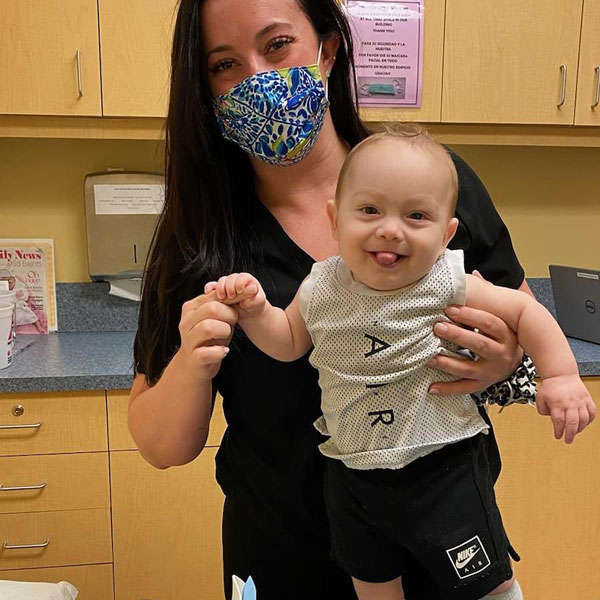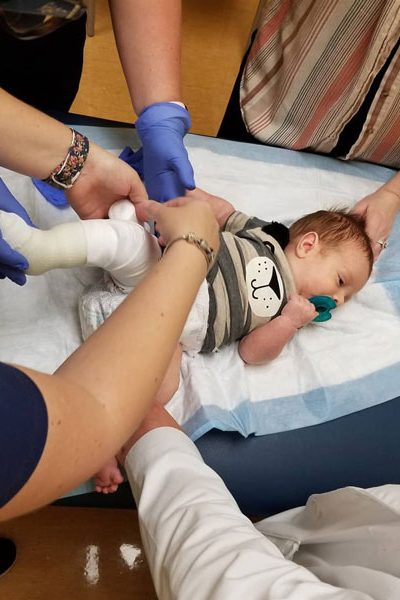Deformity Correction




Bow-legged, or genu varus, is the most common reason children under 2 years of age see an orthopedist. It is actually more common in this age group to have mild bow-legs than to not! If we examine the natural progression of lower limb alignment in a growing child, we can appreciate the typical changes over time and the wide range of what can be considered normal.
Watchful waiting is the only treatment needed for physiologic bowing, as it will improve gradually with time. However, Blounts requires treatment and in the early stages are potentially reversible to normal. Leg braces, called KAFOs (knee-ankle-foot-orthosis), are the treatment of choice for children under 3 years old. Unfortunately, braces are not always effective in treating Blounts. Due to the abnormal growth plate, there is a risk of recurrence throughout childhood.
Surgery may be required for Blounts. Your physician will discuss treatment options which may include a minor surgery called “guided growth” (hemi-epiphysiodesis) or bone realignment surgery, termed an osteotomy.
Genu valgus is common in growing children, especially after age three. If knock-knees are present equally in both legs and are not causing symptoms, physiologic valgus is the most likely diagnosis.
Although physiologic valgus is considered normal, it may be a cosmetic concern for kids and parents. Your doctor may order standing X-rays every 6 months to ensure alignment is improving. If leg alignment is not worsening, most doctors prefer observing until 8 years of age, as the majority of children with knock-knees will improve with time and not need treatment. Other causes of knock-knees that more frequently require surgery are growth plate injuries and metabolic disease (e.g. Rickets).
Leg braces have not been shown to be effective in treating knock-knees. In cases of persistent genu valgus, the preferred surgical method is “guided growth” (hemi-epiphysiodesis). It is a safe and simple procedure that will straighten your child’s legs as they grow. Osteotomies, or cutting and realigning bones, are done for severe cases of genu valgum and in skeletally mature adolescents and adults.
A common concern of parents is when their child walks with in-toeing, often referred to as “pigeon-toed.” Fortunately, the vast majority of these children are considered to have normal variants.The three normal variants that cause in-toeing are femoral anteversion, internal tibial torsion and metatarsus adductus. Your doctor can diagnose these with a four-part physical exam called a rotational profile. Intoeing typically resolves over time as a child grows and does not require aggressive treatment.
Increased internal rotation of the femur (thigh bone), is called anteversion and is the most common cause of in-toeing in older children. Femoral anteversion can also cause a “knock-kneed” appearance. A child that likes to sit in a “W”, rather than cross-legged, is a sign of femoral anteversion, but sitting in a “W” position is not known to be detrimental. Your physician can evaluate your child’s femoral rotation and X-rays are not needed for diagnosis.
Parents can be reassured that almost all cases of femoral anteversion resolve with time. Braces and orthotics have not been shown to be more effective than observation alone for treating femoral anteversion. For parents with athletically-inclined children, it is good to know that coordination and gait patterns continue to mature throughout childhood. If femoral anteversion does not resolve or causes significant functional problems, surgical correction can be performed but typically not advised until after 10-12 years old.
Increased internal rotation of the tibia (shin bone) is the most common cause of in-toeing in young children and toddlers. Parents may have concern for their child “tripping over his or her own feet”. Fortunately, tibial torsion is considered a normal variant and there are no long-term consequences. Children typically show gradual improvement and resolve before 8 years of age. Derotational braces and other orthotics exist, but have not proven to alter the natural history of in-toeing.
Persistent cases of tibial torsion rarely require surgical intervention and are indicated only when a child has severe functional problems. Pathologic causes of internal tibial torsion, such as cerebral palsy, are more often addressed with surgery.
Metatarsus adductus can cause in-toeing and is the most common foot abnormality in newborns, occurring in 3-12% of births. The cause is unknown and can be attributed to an in utero “packaging problem.” The foot appears bean-shaped with a curved lateral border, often occurring on both feet. Metatarsus adductus is a normal variant, but can sometimes be confused with a Clubfoot. Your orthopedic doctor will be able to differentiate the two during the exam.
If the foot is flexible to a straight position, then no treatment is necessary. There is a near 90% rate of spontaneous resolution for metatarsus adductus, usually in the first several months of life. Observation and simple home stretching are most commonly recommended by physicians. For persistent or rigid metatarsus adductus, serial casting or foot braces can be prescribed. Metatarsus adductus rarely requires surgery and is not advised during the early years of life. The long-term outcome of a persistent adductus is most often cosmetic without causing functional issues.
Children who walk with their toes pointing outward may cause concern for parents. Fortunately, out-toeing is most often a benign finding. The most common cause of out-toeing is pes planovalgus, or flat foot, which can be considered a normal variant in children. A child’s medial arch may not develop fully until after age five. Fortunately, children who still have flatfoot later in childhood and adolescence rarely have symptoms.
Out-toeing can be exacerbated by external tibial torsion. Unlike most cases of internal tibial torsion, external rotation may not resolve with age. However, surgical treatment is rarely necessary, and only in symptomatic patients. Femoral retroversion, or external hip rotation, can also cause out-toeing. It is a benign finding in itself, and your physician can evaluate external femoral rotation during your exam.
Flatfoot which is painful is primarily managed with arch supports, custom inserts, or orthotics such as a SMO (supramalleolar orthosis). Cases of flatfoot causing severe symptoms and those with a rigid hindfoot (possible diagnosis of tarsal coalition), may need surgery if conservative measures fail.